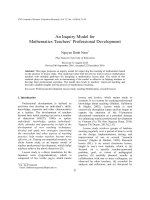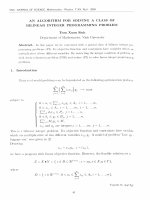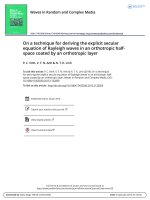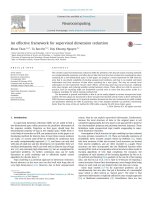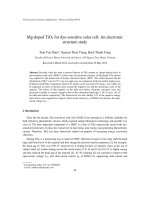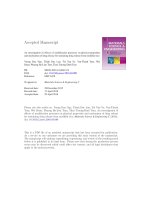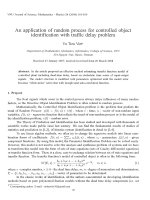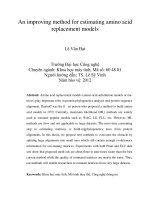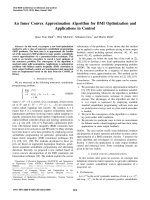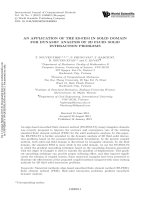DSpace at VNU: An Inquiry Model for Mathematics Teachers’ Professional Development
Bạn đang xem bản rút gọn của tài liệu. Xem và tải ngay bản đầy đủ của tài liệu tại đây (221.92 KB, 8 trang )
VNU Journal of Science: Education Research, Vol. 32, No. 4 (2016) 21-28
An Inquiry Model for
Mathematics Teachers’ Professional Development
Nguyen Danh Nam*
Thai Nguyen University of Education
Received 12 August 2016
Revised 06 September 2016; Accepted 22 December 2016
Abstract: This paper proposes an inquiry model for improving the teaching of mathematics based
on the practice of lesson study. This model provides both pre-service and in-service mathematics
teachers with multiple pathways for designing a mathematics lesson plan. The result of this
research plays an important role in determining if the model is effective in helping teachers to
develop their professional expertise. The model also leads to teachers’ improved teaching and
provides valuable insights into the process of mathematics teaching.
Keywords: Professional development, lesson study, teaching Mathematics, research lesson.
1. Introduction *
lesson, and kenkyu, which means study or
research. It is a system for creating professional
knowledge about teaching (Hiebert, Gallimore
& Stigler, 2002). Lesson study is used
extensively throughout Japan and has begun to
capture the attention of the Vietnamese
educational community as a potential strategy
for enhancing teacher professional development
in Vietnam (Vu Thi Son, Nguyen Duan, 2010;
Nguyen Thi Duyen, 2013) [2, 8].
Lesson study involves groups of teachers
meeting regularly over a period of time to work
on the design, implementation, testing, and
improvement of one or several “research
lessons” (Stigler & Hiebert, 1999). Research
lesson (RL) is an actual classroom lesson,
taught to one’s own students, which is: (a)
focused on a specific teacher-generated
problem, goal, or vision of pedagogical
practice; (b) carefully planned, usually in
collaboration with one or more colleagues; (c)
observed by other teachers; (d) recorded for
analysis and reflection; and (e) discussed by
Professional development is defined as
activities that develop an individual’s skills,
knowledge, expertise and other characteristics
as a teacher. The development of teachers
beyond their initial training can serve a number
of objectives (OECD, 1998): to update
individuals’ knowledge; update individuals’
skills, attitudes and approaches in light of the
development of new teaching techniques;
develop and apply new strategies concerning
the curriculum and other aspects of teaching
practice; help weaker teachers become more
effective, etc. During our empirical research, we
chose lesson study as an inquiry model of
teacher professional development, which helps
teachers achieve the above objectives [3].
Lesson study is a direct translation for the
Japanese term (jugyoukenkyu), which is
composed of two words: jugyo, which means
_______
*
Tel.: 84-979446224
Email:
21
N.D. Nam / VNU Journal of Science: Education Research, Vol. 32, No. 4 (2016) 21-28
22
lesson study group members, other colleagues,
administrators, and/or an invited commentator
(Lewis & Tsuchida, 1998) [3, 4].
Lesson study is based on three following
principles: a) teachers learn best from and
improve their practice by seeing other teachers
teach; b) teachers who have developed deep
understanding of and skill in subject matter
pedagogy should share their knowledge and
experience with colleagues; and c) teachers
should cultivate students’ interest and focus on
the quality of their learning. During our
research, we used a model of collaborative
lesson study that contains five fundamental
phases (see Figure 1) [7, 9]:
i) Phase 1 (Defining RL): Choose a suitable
concept, topic or lesson in the textbooks to
study; identify the goals of the unit of study;
map out a series of lessons that will achieve
these goals; identify the key lesson in this series
which then becomes the RL.
ii) Phase 2 (Planning): Plan carefully the
RL in which describes students’ and teachers’
activities.
iii) Phase 3 (Teaching and Observing): The
RL is taught by a member of the group of
teachers and observed by the other members.
The observing process is focused on students’
thinking, behaviors and responses rather than
the teacher’s ability.
iv) Phase 4 (Lesson Review): Evaluate the
RL and reflecting on its effect. The RL was
revised and then it was taught, observed,
evaluated, and reflected a second time (continue
the cycle if necessary).
v) Phase 5 (Sharing the Results): Document
the findings (produce a report that outlines what
they have learnt with regard to the research
theme and goal). The groups of teachers
periodically meet together to share the revised
lesson or their results on how to teach a certain
concept, topic or lesson.
h
Defining the RL
Collaboratively Planning the RL
Phase 1
Phase 2
Seeing the RL in Action
Teacher and
observers
Phase 3
Discussing the RL
Revising the RL
Teaching the New Version of the RL
Phase 4
Sharing Reflections about the New Version of the RL
Phase 5
Figure 1. The Lesson Study Process in Practice.
N.D. Nam / VNU Journal of Science: Education Research, Vol. 32, No. 4 (2016) 21-28
However, there are some risks and
challenges in applying lesson study in some
Vietnamese schools. It was difficult for teachers
of one school to be able to observe a lesson in
other schools regularly, even in the same
school. The lesson was then evaluated and
revised for further teaching to other groups.
However, the teachers did not get used to of
sharing their ideas of teaching a certain lesson
with others. During the lesson, in order to
anticipate students’ thinking and learning
behaviour, the teachers need to understand
students’ background and learning styles but they
met difficulty in observing all students as well as
their time constraints. Therefore, a group of
schools should create a community of teachers
including online observation room so that they
could share their strategies of teaching a lesson
and revise it until the lesson becomes perfect.
2. Research methodology
The aim of this research is to describe the
effects of the lesson study process on secondary
school teachers from Bac Kan province. The
research will specifically address the following
research questions: (a) How do these teachers
perceive lesson study as a professional
development process? (b) How will engaging in
lesson study affect these teachers’ instructions?
and (c) How does this inquiry model effect on
improving teachers’ teaching ability?
Groups of teachers from Ba Be District,
Cho Moi District (Bac Kan Province) and
researchers from Thai Nguyen University of
Education (n = 45) were given the opportunity
to engage in the pilot implementation and
evaluation of the lesson study process. In
particular, we used inter-school lesson study
method as the complementary way of
increasing the impact of lesson study by joining
with neighboring schools (in both lower and
upper secondary schools). For secondary school
teachers, they worked in small teams to: (a)
formulate a learning goal, (b) design a lesson
that addresses the goal, (c) collect systematic
23
data about student learning and thinking, and
(d) analyze the data and draw conclusions about
student performance. For university researchers,
they were requested to join teachers in and to
contribute their knowledge and experience to
analyze students’ RL activity. The researchers
were also expected to have accumulated deep
knowledge of teaching practice through
observation and participation in RL activities so
that they can provide constructive well
informed comments on lesson observed and the
ensuing discussions (Isoda et al, 2007) [4].
Lesson study teams consist of 5-10
mathematics teachers. However, teachers from
other subjects sometimes were invited to set up
interdisciplinary teams (e.g. Mathematics and
Physics or Mathematics and Biology) so that
they could discuss about how to connect the
content knowledge related to both subjects and
design the interdisciplinary topics. They
selected a RL that addresses academic learning
goals (e.g., understanding specific concepts and
subject matter) and broad goals for
development of intellectual abilities, habits of
mind and personal qualities. Then, they shared
their previous teaching experiences of the topic,
and discuss possible ways to address the lesson
goals. In planning a lesson, they predict how
students are likely to respond to specific
questions, problems and exercises. We also
invited guest observers such as school
principals and researchers from universities to
give supplementary comments. The observers
were encouraged to focus on specific types of
student activity, use rubrics to categorize or
monitor student thinking or behavior during the
lesson [1, 5, 7].
Video was also used as a tool not only to
allow teachers who could not be physically
present to see a lesson, but also to enhance the
review. Video also helped inexperienced and
novice teachers, who were often so traumatized
by the experience of being observed that they
could not remember what exactly happened in
their lesson, to gain useful insights. Even
experienced teachers learned from watching
themselves in action.
24
N.D. Nam / VNU Journal of Science: Education Research, Vol. 32, No. 4 (2016) 21-28
We intended to gain an in-depth
understanding of the lesson study process by
using triangulation method such as teacher
semi-structured interviews, questionnaires, field
notes and observations. Teachers were
interviewed individually after engaging in the
lesson study process. Interviews were also tape
recorded and transcribed. Field notes were
taken during the observations of instructions.
change, and the integral will give the total
distance at any given time.
In the Vietnamese mathematics textbooks, a
definite integral is defined as follows:
Given a function f(x) that is continuous on
an interval [a, b]. Suppose F(x) is an
antiderivative of f(x) on the interval [a, b]. The
difference F(b) - F(a) is called the definite
integral of f(x) from a to b:
b
3. A case study: teaching integration concept
f ( x)dx F ( x)
b
a
F (b) F (a )
a
Integration stems from two different
problems. The first problem is to find the
inverse transform of the derivative. This
concept is known as finding the antiderivative.
The second problem deals with areas and how
to find them. This is the algebraic method of
finding the integral for a function at any point
on the graph.
Phase 1 (Defining the Topic). Definite
integral was chosen for lesson study discussion
because it is a difficult topic that related to the
concept of limit. It also can be interpreted as an
area. All the members of lesson study team
agreed that integrals, together with derivatives,
are the fundamental objects of calculus, with
numerous applications in science and
engineering. Therefore, the instructors should
provide students with an opportunity to gain a
deeper understanding of the connection
between mathematics and the real world.
Phase 2 (Planning). Lesson study team
found a suitable approach in teaching definite
integral concept. The integral comes from not
only trying to find the inverse process of taking
the derivative, but trying to solve the area
problem as well. Therefore, teachers could use
area as a means of describing the concept or use
the inverse problem of derivative concept which
related to velocity. For the derivative, the
motivation was to find the velocity at any point
in time given the position of an object. If the
velocity of an object was known at a particular
time, the integral will show the object’s
position at that time. In other words, the
derivative gave the instantaneous rate of
Phase 3 (Teaching and Observing). After
giving the definition, teachers used ‘drill and
practice’ strategy aimed at helping student
develop calculating skill rather than applied
skill and modeling competency. Observers
realized that this approach of the definition did
not help students understand about area
problem involving integral concept. As a result,
they did not know about some applications of
definite integral in the real world. We can
approximate the area to the x axis by increasing
the number of rectangles under the curve. The
area of these rectangles was calculated by
multiplying length times width. After the area
was calculated, the summation of the rectangles
would approximate the area of the “curved
trapezoid”. As the number of rectangles gets
larger, the better the approximation will be.
Given a function f(x) that is continuous on
the interval [a, b]. We divide the interval
into n subintervals of equal width, x, and from
each interval choose a point, xi* . Then
the definite integral of f(x) from a to b is:
b
a
n
f ( x)dx lim f ( xi* )x
x
i 1
Phase 4 (Lesson Review). After discussion,
teachers and researchers strongly agreed that
the teacher can approach this definition based
upon area problem. The teacher used dynamic
geometry software (e.g GeoGebra) to design a
situation that helps students can interact with
the summation of the area by dragging and
N.D. Nam / VNU Journal of Science: Education Research, Vol. 32, No. 4 (2016) 21-28
compare the difference between uppersum and
lowersum with integral as n tends to infinity
(see Figure 2). After the RL, we realized that
students deeply understand about infinite
25
integral concept. In particular, they can apply
this concept to calculate the area of twodimensional figure and solve some real world
problems as well.
g
a) n = 5
b) n = 500
Figure 2. Approximating the summation of the area of rectangles under the curve.
Phase 5 (Sharing the Results). We shared
the revised lesson plan and other teacher taught
the same lesson in another class. Video was
recorded as a sample lesson so that we could
send it to other schools or even to teacher
training universities. Students and other
teachers were provided with a chance to
observe and analyze the sample lesson about
relating themes such as: concept approach,
teaching methods, assignments, assessments,
pedagogical situation control, students’
engagement,
students’
behavior
and
performance, etc.
In general, the lesson study strategy allowed
teachers to study particular aspects that were
deliberately built into the lesson design, for
example in this case the use of dynamic
geometry environment for approaching the
infinite integral concept and strengthening the
applications of this concept in the real life.
4. Data collection and analyses
During observing RL, the focus was not
what students learnt, but rather how students
learnt. In particular, our observation teams
focused on students’ thinking and behavior, how
they construct the knowledge, how they make
sense of the material, what kinds of difficulties
they have, how they answer questions, how their
thinking changes during the lesson and so on.
Therefore, our observation teams took notes about
some specific strategies that support changes in
student thinking and common misconceptions that
hinder students’ learning.
Following the lesson implementation, the
lesson study groups spent approximately one
hour reflecting and critiquing the lesson.
Researchers from university, who attended the
implementation of the RL, acted as
commentators and advisors during the
discussions. The teacher who taught the RL
shared teaching ideas and the observers, if
needed, shared insights, posed additional
questions and gave suggestions aimed at
planning a new version of the lesson. After that,
the teacher began working on a revised lesson
plan based on what was observed and
discussed. Another teacher volunteered to teach
the revised lesson plan in another class (in the
same term or in the following term) and other
26
N.D. Nam / VNU Journal of Science: Education Research, Vol. 32, No. 4 (2016) 21-28
teachers again came to observe. We used a
reflection log to record what they were
understanding, experiencing and learning from
the process. In conclusion, teachers compiled a
written report of what they had learned and
presented the research lesson to the entire
school and later inter-school club.
During the lesson study process, the lesson
study team found that they were much more
actively involved in controlling and sustaining
the teaching experience. They said that “The
shared instruction made a positive difference in
their planning and instruction”. In the teacher
interview, we also focused on personal
understanding and analyzed their comments
carefully. Mrs Nhan from Cho Ra Lower
Secondary School shared her reflections: “I feel
more confident when I teach the revised lesson.
In particular, regular collaboration with my
colleagues about curriculum objectives, teacher
instruction, teaching aids,… help me learn new
approaches to controlling classroom activities
and instructing students”. Mr Dien from Ba Be
Upper Secondary School expressed his strongly
agreement that there is a positive effect of
lesson study in gaining his teaching
experiences: “I believe that the most effective
place to improve teacher’s teaching
experiences is in the context of a classroom
lesson”. For novice teachers like Mr Chinh and
Mrs Quynh from Cho Moi Upper Secondary
School, peer coaching and mediation training
would improve their abilities to engage in
lesson study more effectively. Receiving
constructive feedback from lesson study team
also played an important role in improving their
pedagogical content knowledge and provided
an opportunity for them to get an in-depth
understanding of the content they are teaching.
In the evaluation questionnaire, teachers
were asked to grade a number of factors from
their collaborative working. Likert scale was
used to evaluate the level of teachers’
agreement about 15 following statements with
point scale from 1 (strongly disagree) to 5
(strongly agree). The mean values of these
factors are summarized below:
Table 1. Lesson Study Team Questionnaire
Items
Share teachers’ previous
experiences teaching a certain topic
or concept
Increase and update teachers’
knowledge of subject matter
Develop teachers’ practical skills
and competency
Raise teachers’ awareness of
different pedagogical strategies and
develops their ability to evaluate
these methods in a constructive way
Motivate inter-school teachers’
collaboration
Help novice and weaker teachers
become more effective
Develop and apply new teaching
strategies concerning the
curriculum
Develop deep understanding of and
skill in subject matter pedagogy
Positive effect on students’ learning
styles
Develop the habits of mind for
better preparation the lesson plan
Meet the students’ learning pace
and goal
Reflecting and critiquing lessons
and textbooks
Develop teachers’ critical thinking
Understand students’ thinking and
behavior
Meet the inter-subject requirements
Mean
3.7
3.9
3.8
3.5
3.5
3.8
4.0
4.0
3.2
3.6
4.1
4.2
4.4
4.2
4.3
In a survey of 45 active lesson study
practitioners in Bac Kan province, 93%
reported that lesson study helped them improve
their teaching and 95% believe that lesson study
is the most effective form of professional
development. Data from Table 1 shows that this
model helps teachers learn about teaching with
technology by observing each other and
discussing the lessons. Moreover, lesson study
also helps teachers get more understanding about
subject curriculum development. During the
discussion, teachers have a chance to perceive the
knowledge of how mathematical topics are related
across grade levels, how student understanding is
built up, kinds of representations and
N.D. Nam / VNU Journal of Science: Education Research, Vol. 32, No. 4 (2016) 21-28
manipulatives that support students’ learning,
students’ state of prior learning, common
misconceptions, and how various teaching
strategies contribute to learning.
In our research, we have also examined
how students learnt as well as their attitudes in
a revised lesson. Fifty five students (n = 52)
were asked to score a number of items in Table
2. Likert scale was used to evaluate the level of
students’ agreement about 7 following
statements with point scale from 1 (strongly
disagree) to 5 (strongly agree). The mean values
of these items are summarized below:
Table 2. Students’ Attitudes towards
in a Revised Lesson
Items
Students were carried out more
activities with practical situations
The teachers’ questions during the
lesson were very easy to understand
Students had more opportunity to
interact with the teacher and other
students
Students could work with small
group or pairwork in a flexible
context
Students knew how to apply
information technology in
representing mathematical models
Students understood about the nature
of definite integral concept
Students understood the application
of definite integral in the real life
Mean
4.2
4.0
3.5
4.1
3.1
3.4
4.3
The results have shown that in a revised
lesson, students carried out more activities and
worked in a collaborative environment.
Teacher’s questions were easy to understand
because the teacher had prepared the questions
very carefully. As a result, there were a lot of
students who understood the definite integral
concept as well as its application in the real life.
The effectiveness of this lesson stems from
lesson study approach in which the teacher and
her/his colleagues designed the lesson together
and revised it right after their teaching.
27
5. Discussion
The purpose of this paper has been to
discuss the use of lesson study model for
professional development in secondary schools.
Results revealed from the data clearly indicate
that this model can serve as a means of teacher
professional development with positive impact
on teacher instructional practice. A long-term
approach for groups of teachers to work
together and to improve student learning in
their school and inter-schools as well.
Lesson plan should be constructed by the
group from different schools rather than on the
individual teacher. For mathematics teachers,
possible focus for lesson study model would be:
Lesson preparation; resources and activities;
use of information and communications
technology; students on task; paired work;
teacher praise; explanations; contexts and
applications;
functional
mathematics;
questioning techniques; reviewing answers;
challenge and extension work; lower attaining
students; notation, layout, language, precision;
pace of activities; use of teaching assistants;
homework; monitoring of student progress;
time management; assessment. As a result,
there is a continued need for further
implementation and future research on the
lesson study model aimed at providing teachers
with an inquiry model to improve their teaching
ability and professional development so that
they can meet the requirement of educational
reform in the next few years.
References
[1] William Cerbin, Bryan Kopp (2006). Lesson
Study as a Model for Building Pedagogical
Knowledge
and
Improving
Teaching.
International Journal of Teaching and Learning
in Higher Education, 18(3), 250-257.
[2] Nguyễn Thị Duyến (2013). Nghiên cứu bài học Một mô hình phát triển năng lực dạy học của
giáo viên Toán. Tạp chí Khoa học, Trường Đại
học Sư phạm Hà Nội, 58, 74-84.
[3] Clea Fernandez, Makoto Yoshida (2004). Lesson
Study - A Japanese Approach to Improving
28
N.D. Nam / VNU Journal of Science: Education Research, Vol. 32, No. 4 (2016) 21-28
Mathematics Teaching and Learning. Lawrence
Erlbaum Associates Publishers.
[4] Masami Isoda, Max Stephens, Yutaka Ohara,
Takeshi Miyakawa (2007). Japanese Lesson
Study in Mathematics - Its impact, Diversity and
Ptential for Educational Improvement. World
Sciencetific Publishing.
[5] Maitree Inprasitha (2011). One Feature of
Adaptive Lesson Study in Thailand: Designing a
Learning Unit. Journal of Science and
Mathematics Education in Southeast Asia, 34(1),
47-66.
[6] Robyn Pierce, Kaye Stacey (2011). Lesson
Study for Professional Development and
Research. Journal of Science and Mathematics
Education in Southeast Asia, 34(1), 26-46.
[7] Lynn C. Hart, Alice Alston, Aki Murata (2011).
Lesson Study Research and Practive in Mathematics
Education - Learning Together. Springer.
[8] Vũ Thị Sơn, Nguyễn Duân (2010). Nghiên cứu
bài học - Một cách tiếp cận phát triển năng lực
nghề nghiệp của giáo viên, Tạp chí Khoa học
Giáo dục, 52, 45-48.
[9] Akihiko Takahashi, Tad Watanabe, Makoto
Yoshida (2006). Developing Good Mathematics
Teaching Practice through Lesson Study: An US
Perspective. Tsukuba Journal of Educational
Study in Mathematics, 25, 197-204.
